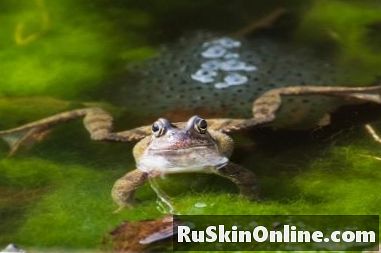
Content
- Algae in the garden pond: causes and remedies
- Why do algae multiply in the garden pond?
- Which types of algae occur?
- First aid with algae: change water
- Test water regularly
- Tips

Algae can also be dangerous to animals in the pond
Algae in the garden pond: causes and remedies
Algae in the pond are not only ugly, they can even be life-threatening for animals and aquatic plants. Especially in the summer months, when the small water heats up, these unloved aquatic plants can explode almost by leaps and bounds. Not always you have to go directly to the chemical club, because there are also many preventive and biological means with which the green plague can be kept in check.
Why do algae multiply in the garden pond?
First: There is no algae-free garden pond and in small quantities, these plants are not harmful. Only if they take over you should intervene, because this speaks for a barked, biological balance and the associated shift of water values.
The most common cause of excessive algae growth is an excess of nutrients. Often the fish are fed too abundantly or the stocking is too dense. The uneaten food and the many droppings settle on the bottom of the pond and rot here, together with plant remains, to pond mud. Starting at a temperature of ten degrees, it releases many nutrients to the pond water. Direct sunlight heats the water. At the same time, as the pond lacks an inlet and outlet, as in a natural body of water, more water evaporates. As a result, the concentration of algae nitrate increases sharply and an algal bloom threatens.
Out of ignorance, when planting or repositioning pond plants, conventional potting soil is sometimes used instead of the special pond substrate. This is enriched with many nutrients that dissolve quickly, so that the concentration in the water rises sharply. As a result, it comes to a rapid nutrient surplus and the dreaded algal bloom.
Which types of algae occur?
First aid with algae: change water
At least as effective as the use of chemical algicides is a renewal of the water in the garden pond. Never change all the water at once, but renew for about three consecutive days.
If you were to replace the entire water, you would inevitably also remove all bacteria and microorganisms necessary for balance. In addition, an extensive change of water means enormous stress for aquatic animals.
It is helpful to use some algae-free fish. These permanently ensure that the algae plague does not get out of hand. The same is true of high-consuming aquatic plants that deprive the algae of nutrients. Many algae species can also be removed manually with a nets or pond sludge sucker.
Test water regularly
So that the water values remain in the Lot it makes sense to check them in the warm season at least weekly. The trade holds water test kits that are very easy to use.
If this proves that the garden pond is not in biological equilibrium, it is advisable to first change one third of the water. Depending on the size of the garden pond, add ten to twenty liters of water from a healthy body of water to the fresh water. The microorganisms in it will immediately start working in your pond and help regulate water levels. Shading the small water for a few hours on very sunny days also has a positive effect on the quality of the water.
Tips
Excessive feeding is unhealthy for the fish because the animals become fatigued and become more susceptible to disease. A healthy fish has a slightly curved, but not a round belly. However, they should not feed so little that the stomach looks sunken. One or two days a week of feeding break will not hurt regularly fed, healthy fish, and you'll be amazed at how clear the water is. A good filtration system that removes algae and excess nutrients is also useful in fish stocking.